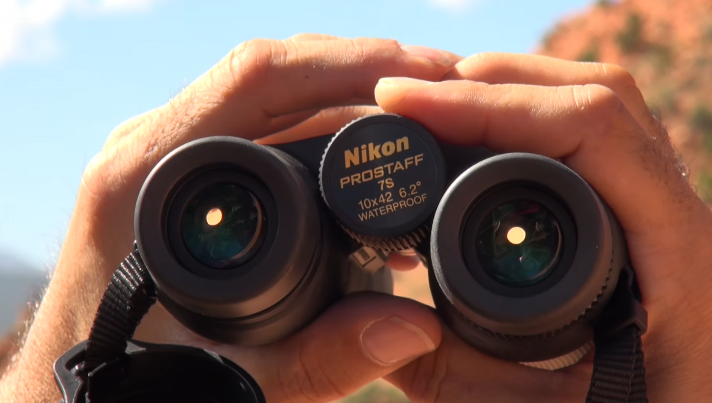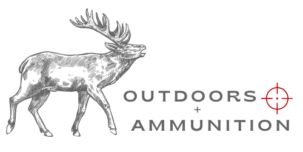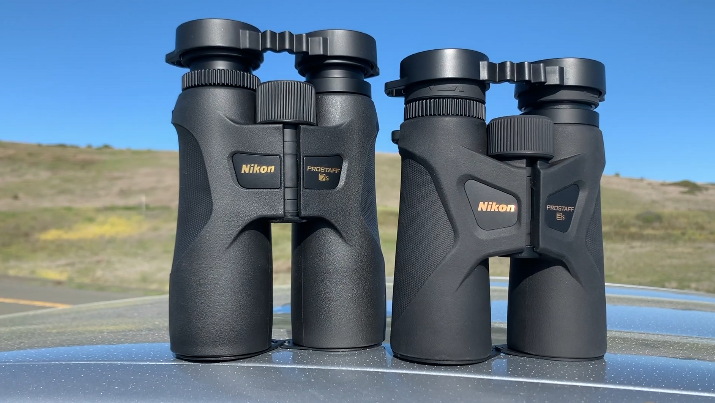If you are struggling to choose between Nikon Prostaff 3s and Nikon Prostaff 7s binoculars, then don’t you worry! We’ve got you covered, we will discuss all the details including the features, pros, and cons of both of these pairs of binoculars.
Here’s a quick comparison between the two, but keep reading for our in-depth overview if you want the whole story on these two pairs of binoculars.
| Nikon Prostaff 3s | Nikon Prostaff 7s | |
| Magnification | 10x or 8x | 10x or 8x |
| Objective Lens Diameter | 42 | 42 or 30 |
| Angular Field of view (Real/degree) | 7.0 | 6.8 |
| Angular field of view (apparent/degree) | 62.9 | 50.8 |
| Field of view @1000m | 122 | 119 |
| Exit pupil | 4.2mm | 5.3mm |
| Eye relief | 15.7mm | 19.5mm |
| Relative brightness | 17.6 | 28.1 |
| Close focusing distance | 3.0 m | 4.0 m |
| Weight | 20.3 Oz | 22.9 Oz |
| Dimensions | 5.9 x 5.1 x 2” | 6.6 x 5.1 x 2.2” |
| Check Price On Amazon | Check Price On Amazon |
Not sure what all this means? Keep reading for a full overview and explanation to help you choose the best pair of binoculars for your needs!
Key differences of Nikon Prostaff 3s vs 7s Binoculars
The first important difference is that some magnification configurations are not available for one Nikon Prostaff 3s, but they are for the 7s. So, if you need a certain configuration, the choice may be made for you.
While most hunters tend to favor the 10 x 42 for their range, bird watchers tend to prefer an 8x pair of binoculars for following small, fast moving targets, as they are easier to hold steady. The Prostaff 3s is also a tad lighter than the 7s if that’s important to your considerations for your gear weight.
The angular field of view (real and apparent) is also different for both the binoculars as mentioned in the chart above. While the field of view at 1000 m of the Nikon Prostaff 3s and 7s is 122 and 119 respectively.
Exit pupil featured in both binoculars differs from each other, the exit pupil featured in the Nikon Prostaff is about 4.2 mm while in the Nikon Prostaff 7s it is around 5.3 mm. then comes the eye relief featured by both binoculars, the Nikon Prostaff 3s has an eye relief of 15.7 mm and the eye relief featured in the Nikon Prostaff 7s is 19.5 mm.
Now if we talk about the prices of these binoculars, there is a little difference between the prices, the Nikon Prostaff 3s costs less than the Nikon Prostaff 7s but both of these binoculars can be bought for less than 200$. That’s pretty reasonable in the world of optics.
BUT, those are just specs, and they don’t tell you everything. In the below section, we’ve done a full review for BOTH of these pairs of binoculars, including survey results from people who have used them in the field if you’re interested in learning about their true performance.
Nikon Prostaff 3s Binoculars Review
The Nikon Prostaff 3s features a magnification range of 10x or 8x while the objective lens is 42 mm in diameter. The lightweight body of these binoculars makes them easier to carry as well.

The prisms used in the Nikon Prostaff 3s are high-reflective silver-alloy coated which helps in providing a bright and clear image. The lenses are multi-layer coated for a better and bright view, helping you to pick out details in your surroundings.
The binoculars also feature the multi-click adjustment system along with turn-and-slide eyecups made of rubber that allows achieving a correct eyepoint, even for the people who wear glasses.
Hunters we surveyed loved the small and light but not compact (pocket size) of the Nikon Prostaff 3s binoculars. The clarity and brightness of view achieved by these binoculars have gathered a lot of praise from users as well. Many people love these particular binoculars as a low-cost option for bird watching and hiking, and the reviews reflect that. Click here to read more reviews and check prices on Nikon Prostaff 3s.
Pros
- Smaller in size
- Lighter in weight
- Cheaper
- Water and fog proof
- Easily adjustable
- Well balanced
- Excellent close focus
- Easily usable by the people who wear glasses
- Higher magnification
- Larger field of view
- Good for bird watching
Cons
- Inferior Lens Coating Compared to the Prostaff 7s
- Move-on chromatic aberration
- Roof prism is not phase correction coated
- Less exit pupil
- Less eye relief
Nikon Prostaff 7s review
The Nikon Prostaff 7s is available in a wider variety of configurations, including: 10×42, 8×42, 10×30, and 8×30. A larger lens diameter (the second number), will let in more light, giving you a better picture.

So, why would you ever choose the 30mm lens? Well, smaller lenses make for more compact binoculars. If you don’t have room for a full-size set in your bag, or you’re looking to travel light, then you might opt for smaller ones. For the record, 8×30 is a perfectly acceptable configuration for bird watching and good for casual activities.
You can only get the 30mm lenses in the Prostaff 7s if you desire a more compact pair of binoculars. So, keep that in mind, BUT the Prostaff 7s also have some other differences with their lenses which you should know about.
The Phase-correction coated roof prisms provide high-resolution images and accurate color reproduction. Higher light transmission across the entire light spectrum is provided by the multilayer coatings on the lenses. A more natural and clearer view can be achieved due to the minimized loss of light caused by reflection.
The user-friendly central focus knob is very intuitive to use and operate, and the rubber-armored coating can withstand extreme use and provides a non-slip grip even in wet weather conditions.
Prostaff 7s users have loved using these binoculars because of the brightness and crystal clear view they provide, especially in low light (ie. dawn or dusk). The rubber-armored coating is a win-win for buyers as well, as it’s easier to hold even with gloves on. The Prostaff 7s also features Impressive close focus and the waterproofing of these binoculars make them more durable. Click here to check prices on the Prostaff 7s.
Pros
- Longer eye relief
- Multi click adjustment
- Turn-and-slide rubber eyecups
- High-reflection mirror coated prisms
- Lens higher in quality and more multi-layer coated
- Roof prism Phase-correction coated
- Lateral chromatic aberration
- Rubber armoring for shock resistance
- Water and fog proof with nitrogen gas
- Longer exit pupil
- Higher relative brightness
Cons
- Costs more than the 3s
- Heavier than the 3s
- Longer than the 3s
- Smaller magnification range
Conclusion
Both 3s and 7s are good choices according to their prices but it is quite clear that the Nikon Prostaff 7s is a better choice and worth the extra money. While the Prostaff 3s is decent, its light transmission pales in comparison to the Prostaff 7s.
Our winner here is the Prostaff 7 because these binoculars clearly show how wonderful a well-made moderate-priced roof prism binocular can be. So, if you can fit the extra few bucks for these in your budget, you should do so. Click here to compare specs and prices for these binoculars.


